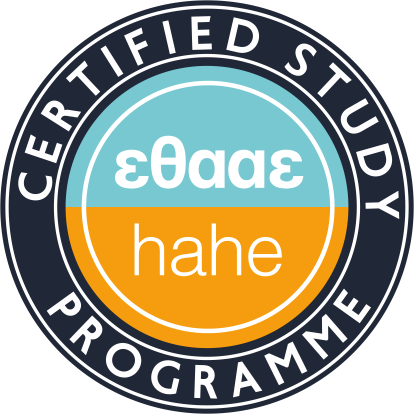Computer Networks
Teaching Staff: Oikonomou Konstantinos, Tsoumanis Georgios
Code: HY160
Course Type: Core Course
Course Level: Undergraduate
Course Language: Greek
Delivery method: Lectures
Semester: 3rd
ECTS: 5
Teaching Units: 5
Lecture Hours: 4
Lab/Tutorial Hours: 2L
Total Hours: 6
E Class Page: https://opencourses.ionio.gr/courses/DDI283/
Curricula: Revamped Curriculum in Informatics from 2025
The course introduces students to the fundamental principles and technologies of computer networks. The OSI and TCP/IP protocol architecture models are presented, along with the functions of each layer and the basic protocols (IP, TCP, UDP). The principles of information transmission, multiplexing techniques, and the differences between circuit switching and packet switching are analyzed. The functions of the data link layer (framing, error control) and the mechanisms of medium access control (Aloha, CSMA) are examined. Local area network technologies (Ethernet, Token Ring, Token Bus, FDDI), the main routing algorithms (Dijkstra, Bellman-Ford), as well as the concepts of reliability, flow control, and congestion control are presented. Finally, an introduction is given to queuing theory (M/M/1, M/M/k) and to Little’s Law for evaluating network performance.
The course introduces students to the fundamental principles and technologies of computer networks. The OSI and TCP/IP protocol architecture models are presented, along with the functions of each layer and the basic protocols (IP, TCP, UDP). The principles of information transmission, multiplexing techniques, and the differences between circuit switching and packet switching are analyzed. The functions of the data link layer (framing, error control) and the mechanisms of medium access control (Aloha, CSMA) are examined. Local area network technologies (Ethernet, Token Ring, Token Bus, FDDI), the main routing algorithms (Dijkstra, Bellman-Ford), as well as the concepts of reliability, flow control, and congestion control are presented. Finally, an introduction is given to queuing theory (M/M/1, M/M/k) and to Little’s Law for evaluating network performance.
1. Introduction to Computer Networks
-
Historical evolution of networking technologies and the Internet
-
Introduction to communication networks and the services they provide
-
Types and topologies of networks
2. Network Architectures
-
Design principles
-
Layered architecture and layering
-
Protocols and standards
-
Reference models: OSI and TCP/IP
3. Principles of Information Transmission
-
Types of multiplexing
-
Circuit switching and packet switching
-
Queueing theory models
4. Data Link Layer (Part A)
-
Framing
-
Error control
-
Flow control
-
Introduction to M/M/1 systems
5. Data Link Layer (Part B)
-
Data link protocols
-
Sliding window protocols
-
Little’s Law
6. Multiple Access Control
-
Multiple access with and without contention
-
Random access protocols: Aloha, CSMA, CSMA/CD, CSMA/CA
-
Queueing networks
-
Simulation of a queueing system
7. Local Area Network (LAN) Technologies
-
Ethernet, Token Ring, Token Bus, FDDI
-
Interconnection of LANs: bridges, switches
8. Network Layer (Part A)
-
Framing and addressing
-
IP, NAT, ICMP, ARP, DNS
-
IP protocol: IPv4 and IPv6
9. Network Layer (Part B)
-
Routing algorithms: Dijkstra, Bellman-Ford
-
Hierarchical routing
-
Routing protocols: RIP, OSPF, BGP
10. Network Design and Subnetting
-
Use of subnet masks for network segmentation
-
Subnetting with and without classes
11. Transport Layer (Part A)
-
Connection-oriented and connectionless transport
-
Reliability and process-to-process communication
-
Port numbers, multiplexing/demultiplexing
-
UDP and TCP protocols
12. Transport Layer (Part B)
-
TCP connection establishment and termination
-
Segment transmission, numbering, header structure
-
Error control and congestion control
13. Application Layer
-
-
Application layer protocols: DNS, FTP, SMTP, WWW, HTTP
-
-
Tanenbaum, A. S., Feamster, N., & Wetherall, D. (2021). Computer Networks (6th American Edition). Klidarithmos Publications. ISBN: 9789606451836.
-
Kurose, J. F., & Ross, K. W. (2021). Computer Networking: A Top-Down Approach (8th Edition). Giourdas Publications. ISBN: 9789605127459.
-
Forouzan, B. A., & Mosharraf, F. (2023). Computer Networks – A Top-Down Approach (1st Revised Edition). Broken Hill Publishers Ltd. ISBN: 9789925351558.
-
Forouzan, B. A. (2022). Data Communications and Networking with TCP/IP Protocol Suite (1st Edition). Broken Hill Publishers Ltd. ISBN: 9789925350117.
-
Peterson, L. L., & Davie, B. S. (2009). Computer Networks: A Systems Approach (4th Edition). Klidarithmos Publications.
Mode of Delivery: Face-to-face in the classroom and laboratory.
Teaching Organization:
| Activity | Semester Workload |
| Lectures | 52 |
| Laboratory Lectures/Tutorials | 26 |
| Individual Written Assignment | 22 |
| Independent Study | 50 |
| Total Course Workload | 150 |
-
Slides for the theoretical part of the course, available through the e-class platform.
-
Laboratory guides, available through the e-class platform.
-
Self-assessment questions and exercises via the e-class platform.
-
Support of the learning process through the e-class platform.
Final written examination including:
-
Short-answer questions
-
Problem solving
-
Multiple-choice questions
Midterm examination including:
-
Short-answer questions
-
Problem solving
-
Multiple-choice questions
Individual written assignment including:
-
Coding and simulation
-
Conclusions and analysis
Back
Studies
e-mail: cs@ionio.gr




 call for applications 2025-26 (v2)
call for applications 2025-26 (v2)